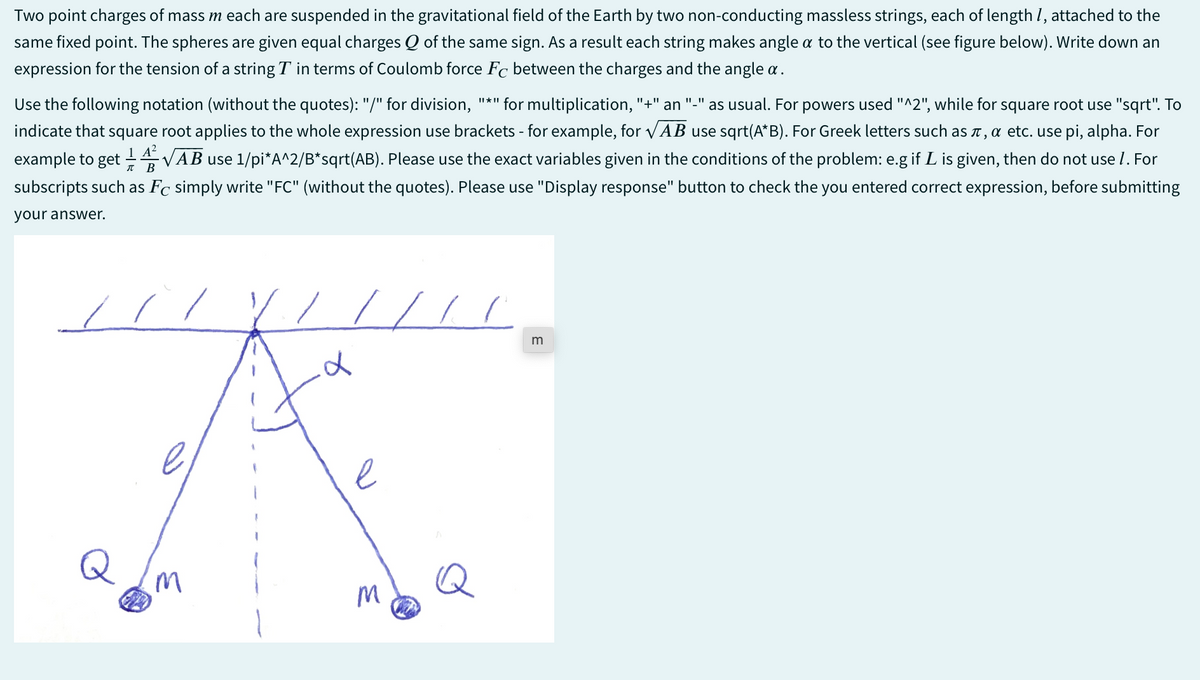Two point charges of mass m each are suspended in the gravitational field of the Earth by two non-conducting massless strings, each of length 1, attached to the same fixed point. The spheres are given equal charges Q of the same sign. As a result each string makes angle a to the vertical (see figure below). Write down an expression for the tension of a string T in terms of Coulomb force Fc between the charges and the angle a. Use the following notation (without the quotes): "/" for division, "*" for multiplication, "+" an "_" as usual. For powers used "^2", while for square root use "sqrt". To indicate that square root applies to the whole expression use brackets - for example, for √AB use sqrt(A*B). For Greek letters such as л, α etc. use pi, alpha. For example to get 14√AB use 1/pi*A^2/B*sqrt(AB). Please use the exact variables given in the conditions of the problem: e.g if L is given, then do not use 1. For subscripts such as Fc simply write "FC" (without the quotes). Please use "Display response" button to check the you entered correct expression, before submitting your answer. B d e M M E
Two point charges of mass m each are suspended in the gravitational field of the Earth by two non-conducting massless strings, each of length 1, attached to the same fixed point. The spheres are given equal charges Q of the same sign. As a result each string makes angle a to the vertical (see figure below). Write down an expression for the tension of a string T in terms of Coulomb force Fc between the charges and the angle a. Use the following notation (without the quotes): "/" for division, "*" for multiplication, "+" an "_" as usual. For powers used "^2", while for square root use "sqrt". To indicate that square root applies to the whole expression use brackets - for example, for √AB use sqrt(A*B). For Greek letters such as л, α etc. use pi, alpha. For example to get 14√AB use 1/pi*A^2/B*sqrt(AB). Please use the exact variables given in the conditions of the problem: e.g if L is given, then do not use 1. For subscripts such as Fc simply write "FC" (without the quotes). Please use "Display response" button to check the you entered correct expression, before submitting your answer. B d e M M E
Principles of Physics: A Calculus-Based Text
5th Edition
ISBN:9781133104261
Author:Raymond A. Serway, John W. Jewett
Publisher:Raymond A. Serway, John W. Jewett
Chapter19: Electric Forces And Electric Fields
Section: Chapter Questions
Problem 6P
Related questions
Question

Transcribed Image Text:Two point charges of mass m each are suspended in the gravitational field of the Earth by two non-conducting massless strings, each of length 1, attached to the
same fixed point. The spheres are given equal charges Q of the same sign. As a result each string makes angle a to the vertical (see figure below). Write down an
expression for the tension of a string T in terms of Coulomb force Fc between the charges and the angle a.
Use the following notation (without the quotes): "/" for division, "*" for multiplication, "+" an "_" as usual. For powers used "^2", while for square root use "sqrt". To
indicate that square root applies to the whole expression use brackets - for example, for √AB use sqrt(A*B). For Greek letters such as л, α etc. use pi, alpha. For
example to get 14√AB use 1/pi*A^2/B*sqrt(AB). Please use the exact variables given in the conditions of the problem: e.g if L is given, then do not use 1. For
subscripts such as Fc simply write "FC" (without the quotes). Please use "Display response" button to check the you entered correct expression, before submitting
your answer.
B
d
e
M
M
E
Expert Solution
This question has been solved!
Explore an expertly crafted, step-by-step solution for a thorough understanding of key concepts.
Step by step
Solved in 2 steps with 1 images

Recommended textbooks for you

Principles of Physics: A Calculus-Based Text
Physics
ISBN:
9781133104261
Author:
Raymond A. Serway, John W. Jewett
Publisher:
Cengage Learning

Physics for Scientists and Engineers: Foundations…
Physics
ISBN:
9781133939146
Author:
Katz, Debora M.
Publisher:
Cengage Learning


Principles of Physics: A Calculus-Based Text
Physics
ISBN:
9781133104261
Author:
Raymond A. Serway, John W. Jewett
Publisher:
Cengage Learning

Physics for Scientists and Engineers: Foundations…
Physics
ISBN:
9781133939146
Author:
Katz, Debora M.
Publisher:
Cengage Learning
